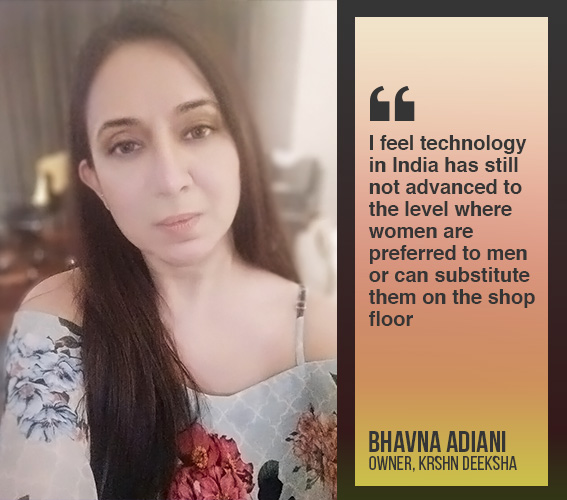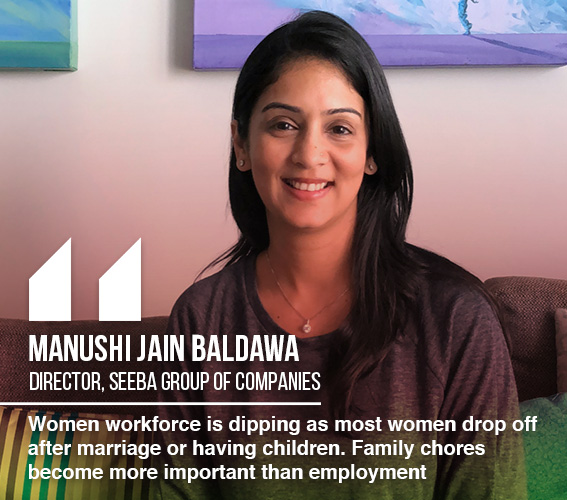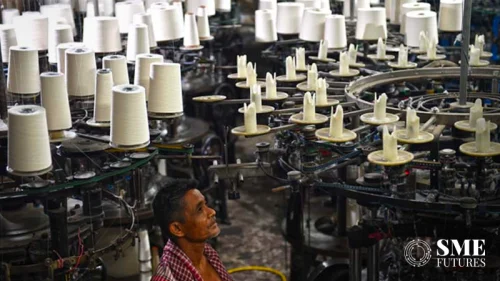A century ago, it was a social taboo for women to work outside homes. As time passed, they began to cross the threshold to earn. Yet, their involvement largely remained restricted to jobs that required the motherly touch; for instance, nursing and teaching. When it came to physically challenging shop floor jobs at manufacturing units, there were few takers among the women, and fewer offers made to them. But then, neither did anyone have the confidence that they could take up such jobs.
The National Sample Survey (NSS) (68th Round) indicates a fall in labour force participation rate among women aged 15-59 years. For rural women, it dropped from 52.2 per cent in 2004-05 to 37.8 per cent in 2011-12. Urban female worker participation went down from 26.1 per cent to 22.2 per cent. Global Wage Report 2016-17 highlights that women represent 63 per cent of the lowest paid wage labour workforce in India.
A UPS manufacturing factory in a metro city (name withheld on request) has only one percent of women employed in its assembly line. Overall their workforce, including in the corporate office, comprises 8 per cent women.
According to Manushi Jain Baldawa, member, ASCENT Foundation and director of Seeba Group of Companies, family responsibilities often hold a woman back. “I think it is a debate between policy and intent. While they are getting more educated, their number in workplaces is dipping because most women drop off after marriage or having children. Family responsibilities become more important than seeking employment for them,” she says.
Structural reforms and employment policies do not necessarily cater to needs of women, Baldawa remarks. “It’s only now, after gender equality became a global issue, that we have better policies to welcome women back into the workforce post-career breaks. We need to not only focus on NEETs (not in education, employment or training) but also ‘re-hire’ from the gender pool rather than just the millennial pool,” she feels.

Wherever there is heavy machinery, harmful chemical or extremely loud noise involved, women are kept at bay, opines Bhavna Adiani, owner of jewellery brand Krshn Deeksha. “I feel technology in India has still not advanced to the level where women are preferred to men or can substitute them on the shop floor,” she says.
A study done by consulate general of Sweden in India in 2017 supports the observation. It shows that participation rate of women went up to 12 per cent in sectors like pc engineering. However, it fell to three per cent in core engineering sector. Consul General of Sweden Ulrika Sundberg, as quoted in a news report, says, “Only 27 per cent of educated women in India work in the industry, which is less than one-fourth of the capacity trained. This number currently keeps decreasing while globally women are increasing their presence in the job market.”
“Despite the progress achieved and the commitments made for further improvement, women’s prospects in the world of work are still a long way from being equal to men’s,” says Deborah Greenfield, ILO deputy director-general for policy, in the report. The findings also confirm that there is a gender gap in wages and social protection too. On the other hand, there are still misconceptions that women cannot work on the shop floors as there is lit of heavy lifting to do. Another reason is of negative social attitudes towards women working at plants. All this impacts the working environment.
What women want
According to the World Bank numbers, 18 per cent of women are employed in manufacturing and construction and 22 per cent in the service sector while a major chunk of 60 per cent is into farming. Over the years, they have evolved as a confident gender. They no longer wish for a nine to five desk job. They want to explore jobs where they get to practise their skills or get challenging roles. Yet, it is not the manufacturing segment they choose. Their numbers in this segment are the lowest.
Manisha Sangani, member, ASCENT Foundation and director and CEO of Mumbai’s Priority Marketing, deals with marketing of fashion brands in India. According to her, the number of women working on shop floors is not increasing at the pace it should. “Women traditionally have shied away from working on shop floors due to reasons such as safety concerns as well as long and inflexible work hours. Though slow, evolution is happening. At our own retail stores, Aspen Watches and Just Retail, we treat women as equals but simultaneously ensure that there is a safety factor involved and check on their training schedules as make sure they are growing in a safe environment.”
Mumbai-based Seeba Group of Companies has a manufacturing unit of metal kitchenware and homeware. As per the figures released by them, the number of women on shop floors varies between 15-20 per cent. Most of them are involved in work that involves dexterity and fine attention to detail like polishing and packaging departments. According to director Manushi Jain Baldawa, they will soon hire women to run a few machines. “The scenario of working women is changing gradually. Honestly, women’s participation on shop floors has just begun to rise in last 5-10 years. It still remains at low levels. This is primarily because of increased gender diversity and the belief that women cannot work on machines. That perception is changing, albeit very slowly. Another issue is the conduciveness of the workplace for women, in terms of basic amenities, fair wages, personal safety and other factors,” Baldawa remarks.

Manufacturing is no longer a male-dominated bastion. More women are opting to work in the sector, says Sekaran Letchumanan, vice-president of operations at Flex India. Their Chennai Industrial Park has 65 per cent male and 35 per cent female employees. “The number of women in the workforce is significantly higher than that a decade ago. We strive to ensure that all Flex employees are empowered to do their best work, with ample opportunity for career advancement.”
Winds of change
Employment is a significant element in the advancement of women towards economic independence. In India, it was in 80s that reforms like black board mission started to lead the way of women progression. It created growth in the education sector with employment of women teachers. A decade earlier, Mahatma Gandhi National Rural Employment Guarantee Act (MGNREGA) gave huge opportunity to women in rural areas who wanted to do work other than domestic chores. According to research conducted by the Rediff labs in 2016, MGNREGA has seen increased women participation over the last five years and now employs slightly more women (52 per cent) than men (48 per cent). Even initiatives from the government such as Skill India, Make in India and gender-based quotas have spurred positive changes in the society.
 Uma Maheswari Santhanaraj, who works as technical trainer and advisor at Flex India in Chennai, joined the company 10 years ago as an operator and has now become a trainer. She trains specially abled workers at the factory.
Uma Maheswari Santhanaraj, who works as technical trainer and advisor at Flex India in Chennai, joined the company 10 years ago as an operator and has now become a trainer. She trains specially abled workers at the factory.
The automotive sector has already done a lot to create synchronicity between hiring of men and women. Recently Tata Motors which already has a fair share of women employees working on the shop floors has said it will ensure their employability with the target of 25 per cent of all the future hiring.
In his blog post, Gajendra Chandel, chief human resource officer at Tata Motors, explains why there is a need for more women on shop floors. “Indian women have successfully defied traditions and stereotypes to achieve great feats in various fields. From the organisational point of view, women employees clearly add value on several parameters. They tend to bring in a great eye for quality and detail orientation, along with finesse in craftsmanship. They possess skill sets for manufacturing and are keen to work on the shop floor. Having more women on the shop floor helps change work culture at the plants. This, in turn, helps improve shop floor output, quality and discipline, which are vital factors to enhance competitiveness,” he says.
Anand Group, an automobile component manufacturer, has 49 manufacturing locations pan India where the percentage of female workforce ranges from a minimum of 30% to maximum of 95 per cent in its various plants.
JCB India, a manufacturer of construction and agriculture equipment, also employs a large number of women employees at its plants in different locations. At its Jaipur site, women account for about a third of the total workforce.
Kirloskar Brothers Limited in 2011 established an all-women plant in Coimbatore where water pumps are manufactured and assembled. It has already won many national awards, including a place in Limca Book of Records.
United Technologies has established an all-women assembly line at its air conditioner manufacturing facility in Gurgaon.
Samsung has opened 18 technical schools in India, one of which is in Patna and is India’s first female-only technical training centre. It imparts skills to over 5,000 women each year.
What companies can do
Talking about the automobile sector, in particular, Gajendra Chandel of Tata Motors points out that it is essential that auto companies build better talent resources. One way to do this quickly is by focusing on gender diversity on the shop floor. He feels companies can harness untapped potential near the plant sites by employing local women. Another way of empowering women in the manufacturing sector is to give them skills. Many companies set up their skill development centres or tie up with government/education centres to impart knowledge. This way companies can encourage women to participate in the labour force. An extensive maternity break, crèche facilities at factory sites and safe work environment too encourage women to take up jobs on shop floors. For instance, companies may set up definite shift timing which is suitable for the female employees.
“Through these initiatives, we should be able to recruit, train and encourage more women to join our plants. The hope is that we can increase the numbers of women employees on the shop floor from the current levels of three to four per cent to 15 to 20 per cent in the next few years,” writes Chandel in his blog post.
Women are considered as more loyal, stable, disciplined and committed employees. Recognising their value and to attract them to its workforce, Flex India has designed special programmes for female employees. According to Sekaran Letchumanan, the company carries out focused diversity hiring where there is special walk-in conducted only for women. There are consistent wellness and empowerment programmes conducted as part of CSER partnership. They have hired women employees as welfare officers to address grievances. “Female counsellors, female shift supervisors at night, crèche facilities and POSH (prevention of sexual harassment) committees are some of our initiatives to attract and encourage women employees,” he elaborates.
In a growing economy like ours, changing workplace ethics will mean more gates opening up. There is a genuine demand for floor staff, especially with the Make in India initiative.












